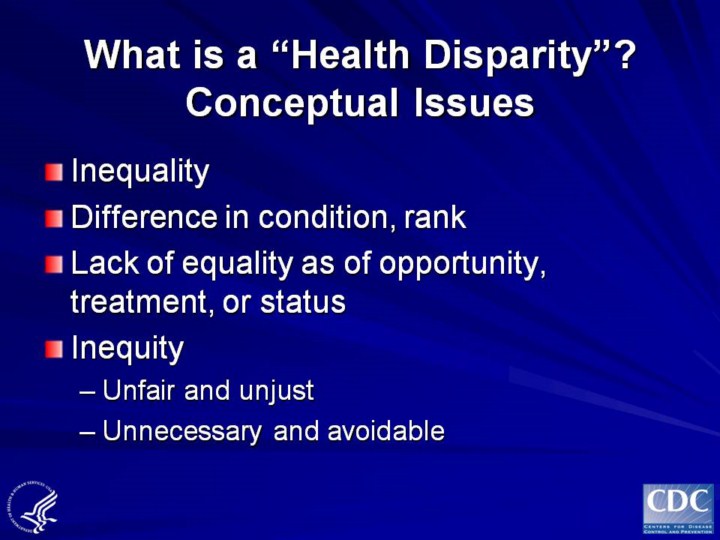| front |1 |2 |3 |4 |5 |6 |7 |8 |9 |10 |11 |12 |13 |14 |15 |16 |17 |18 |19 |20 |21 |22 |23 |24 |25 |26 |27 |28 |29 |30 |31 |32 |33 |34 |35 |36 |37 |38 |39 |40 |41 |42 |43 |44 |45 |46 |47 |48 |49 |50 |51 |52 |53 |54 |55 |56 |57 |58 |review |
 |
What is a “Health Disparity”? Conceptual Issues -- Inequality -- Difference in condition, rank -- Lack of equality as of opportunity, treatment, or status -- Inequity Unfair and unjust Unnecessary and avoidable
First, let me define, “Health Disparity” and discuss some conceptual issues. Most dictionaries define “disparity” as: inequality; difference in age, rank, condition. .. Disparity and difference are synonyms in most dictionaries. Inequality is defined as: lack of equality as of opportunity, treatment or status. Inequity, though, signifies an ethical judgment, an instance of unfairness or unjustness. Another level is added if one includes a judgment of what is unnecessary and avoidable. There are disagreements regarding the definition and use of the terms “disparity”, “inequality”, and “inequity”. These disagreements center on which term to use, whether a judgment of what is avoidable and unfair is included, and how these judgments are made. These conflicting views have implications for resource allocation and reflect different political ideologies. Decisions regarding what is avoidable and unjust are not simple, but are based upon what we currently know, are political decisions based on resources and ideology, who is deciding what is avoidable and unjust, and how it is decided. For example, if you start with the premise that health is solely an individual’s responsibility, then you will not consider other factors that are amenable to intervention. In the context of public health and social science, “Disparity” has begun to take on the implication of injustice, but still may be distinguished from the general term “inequality.” Conceptually, a “health disparity” could be viewed as a chain of events signified by a difference in: 1) health status; 2) a particular health outcome that deserves scrutiny; 3) access to, utilization of, and quality of care; or 4) environment. Such a difference should be evaluated in terms of both inequality and inequity, since what is unequal is not necessarily inequitable.
Source: “Slides for Judith.ppt”
|